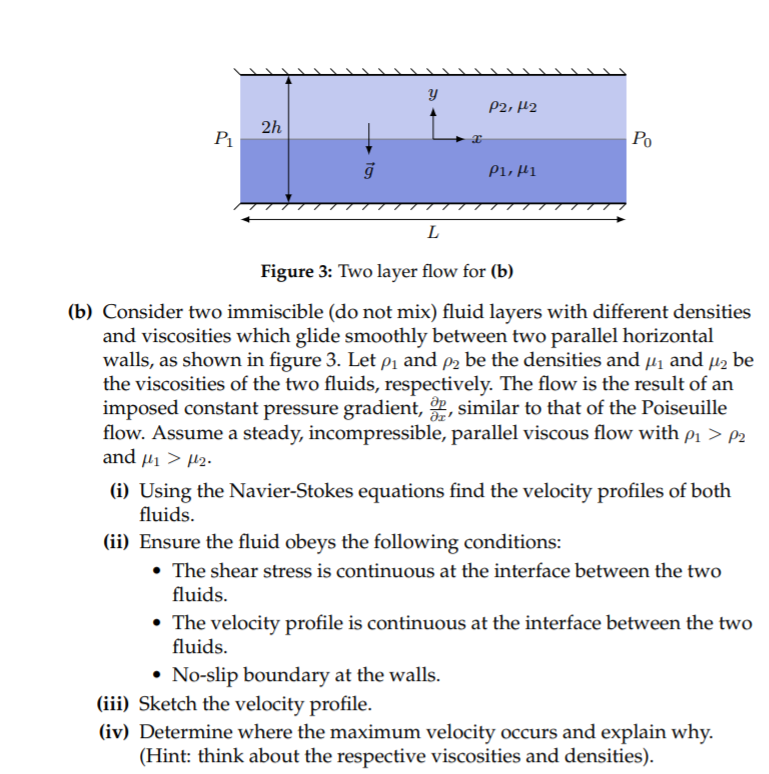P2, 42 2h P1 Po P1, Hi L Figure 3: Two layer flow for (b) (b) Consider two immiscible (do not mix) fluid layers with different densities and viscosities which glide smoothly between two parallel horizontal walls, as shown in figure 3. Let pı and p2 be the densities and µ1 and µ2 be the viscosities of the two fluids, respectively. The flow is the result of an imposed constant pressure gradient, 2, similar to that of the Poiseuille flow. Assume a steady, incompressible, parallel viscous flow with p1 > P2 and µi > µ2- (i) Using the Navier-Stokes equations find the velocity profiles of both fluids. (ii) Ensure the fluid obeys the following conditions: • The shear stress is continuous at the interface between the two fluids. • The velocity profile is continuous at the interface between the two fluids. No-slip boundary at the walls. (iii) Sketch the velocity profile. (iv) Determine where the maximum velocity occurs and explain why. (Hint: think about the respective viscosities and densities).
P2, 42 2h P1 Po P1, Hi L Figure 3: Two layer flow for (b) (b) Consider two immiscible (do not mix) fluid layers with different densities and viscosities which glide smoothly between two parallel horizontal walls, as shown in figure 3. Let pı and p2 be the densities and µ1 and µ2 be the viscosities of the two fluids, respectively. The flow is the result of an imposed constant pressure gradient, 2, similar to that of the Poiseuille flow. Assume a steady, incompressible, parallel viscous flow with p1 > P2 and µi > µ2- (i) Using the Navier-Stokes equations find the velocity profiles of both fluids. (ii) Ensure the fluid obeys the following conditions: • The shear stress is continuous at the interface between the two fluids. • The velocity profile is continuous at the interface between the two fluids. No-slip boundary at the walls. (iii) Sketch the velocity profile. (iv) Determine where the maximum velocity occurs and explain why. (Hint: think about the respective viscosities and densities).
Elements Of Electromagnetics
7th Edition
ISBN:9780190698614
Author:Sadiku, Matthew N. O.
Publisher:Sadiku, Matthew N. O.
ChapterMA: Math Assessment
Section: Chapter Questions
Problem 1.1MA
Related questions
Question

Transcribed Image Text:P2, µ2
2h
P1
Po
ρ1, μι
L
Figure 3: Two layer flow for (b)
(b) Consider two immiscible (do not mix) fluid layers with different densities
and viscosities which glide smoothly between two parallel horizontal
walls, as shown in figure 3. Let pı and p2 be the densities and µ1 and µ2 be
the viscosities of the two fluids, respectively. The flow is the result of an
imposed constant pressure gradient, 2, similar to that of the Poiseuille
flow. Assume a steady, incompressible, parallel viscous flow with p1 > P2
and µi > µ2-
(i) Using the Navier-Stokes equations find the velocity profiles of both
fluids.
(ii) Ensure the fluid obeys the following conditions:
The shear stress is continuous at the interface between the two
fluids.
• The velocity profile is continuous at the interface between the two
fluids.
No-slip boundary at the walls.
(iii) Sketch the velocity profile.
(iv) Determine where the maximum velocity occurs and explain why.
(Hint: think about the respective viscosities and densities).
to
Expert Solution
This question has been solved!
Explore an expertly crafted, step-by-step solution for a thorough understanding of key concepts.
This is a popular solution!
Trending now
This is a popular solution!
Step by step
Solved in 3 steps with 4 images

Knowledge Booster
Learn more about
Need a deep-dive on the concept behind this application? Look no further. Learn more about this topic, mechanical-engineering and related others by exploring similar questions and additional content below.Recommended textbooks for you

Elements Of Electromagnetics
Mechanical Engineering
ISBN:
9780190698614
Author:
Sadiku, Matthew N. O.
Publisher:
Oxford University Press

Mechanics of Materials (10th Edition)
Mechanical Engineering
ISBN:
9780134319650
Author:
Russell C. Hibbeler
Publisher:
PEARSON

Thermodynamics: An Engineering Approach
Mechanical Engineering
ISBN:
9781259822674
Author:
Yunus A. Cengel Dr., Michael A. Boles
Publisher:
McGraw-Hill Education

Elements Of Electromagnetics
Mechanical Engineering
ISBN:
9780190698614
Author:
Sadiku, Matthew N. O.
Publisher:
Oxford University Press

Mechanics of Materials (10th Edition)
Mechanical Engineering
ISBN:
9780134319650
Author:
Russell C. Hibbeler
Publisher:
PEARSON

Thermodynamics: An Engineering Approach
Mechanical Engineering
ISBN:
9781259822674
Author:
Yunus A. Cengel Dr., Michael A. Boles
Publisher:
McGraw-Hill Education

Control Systems Engineering
Mechanical Engineering
ISBN:
9781118170519
Author:
Norman S. Nise
Publisher:
WILEY

Mechanics of Materials (MindTap Course List)
Mechanical Engineering
ISBN:
9781337093347
Author:
Barry J. Goodno, James M. Gere
Publisher:
Cengage Learning

Engineering Mechanics: Statics
Mechanical Engineering
ISBN:
9781118807330
Author:
James L. Meriam, L. G. Kraige, J. N. Bolton
Publisher:
WILEY